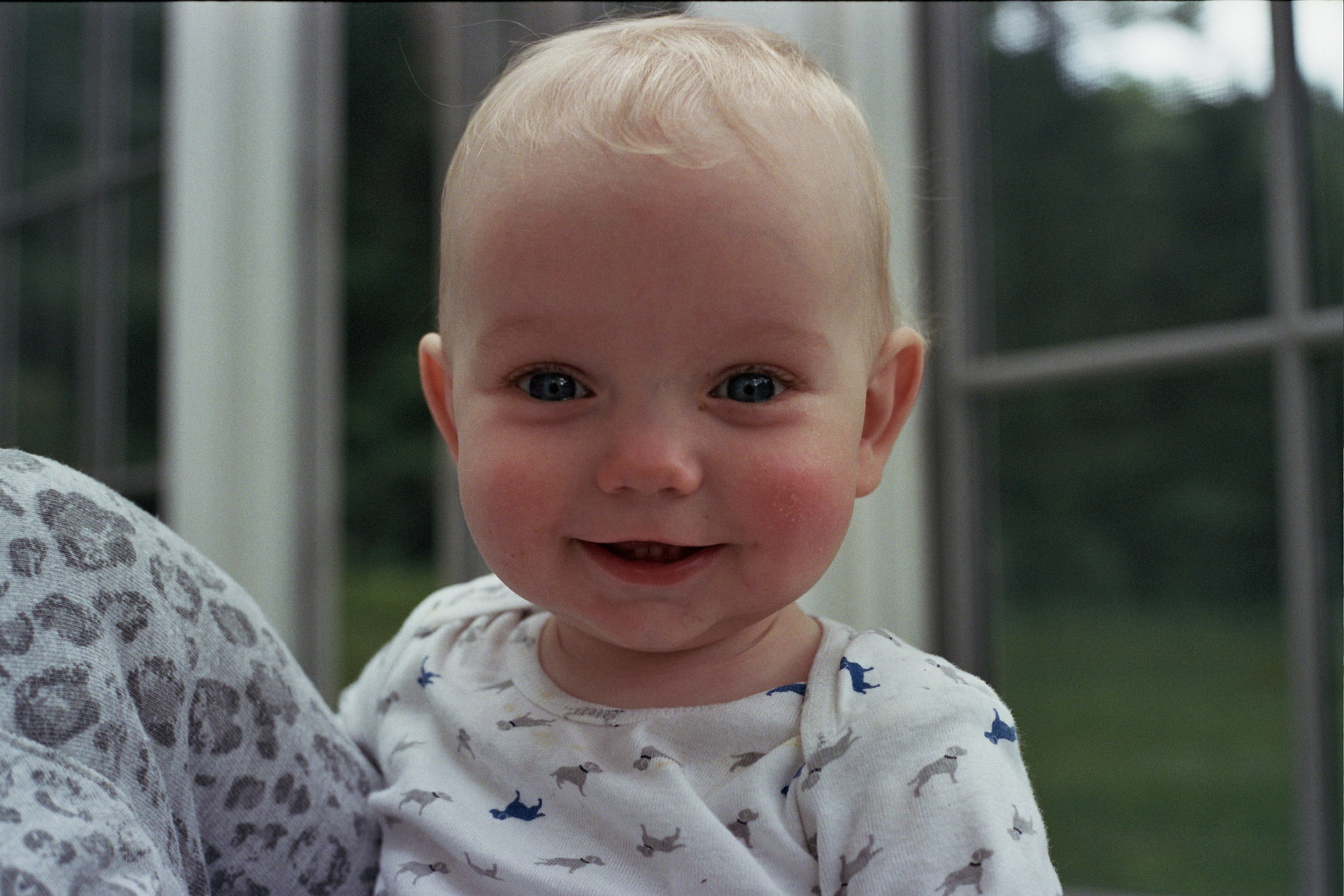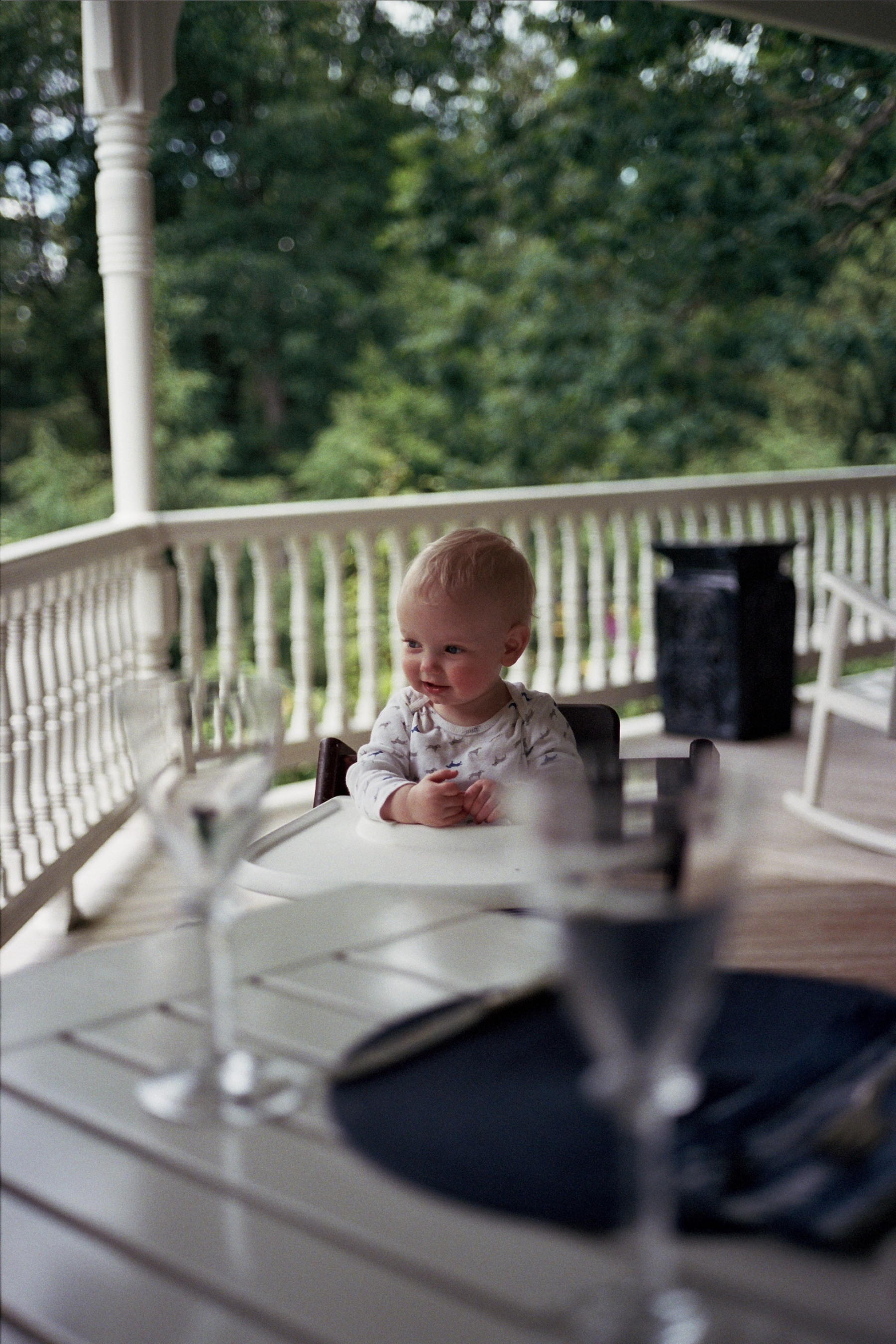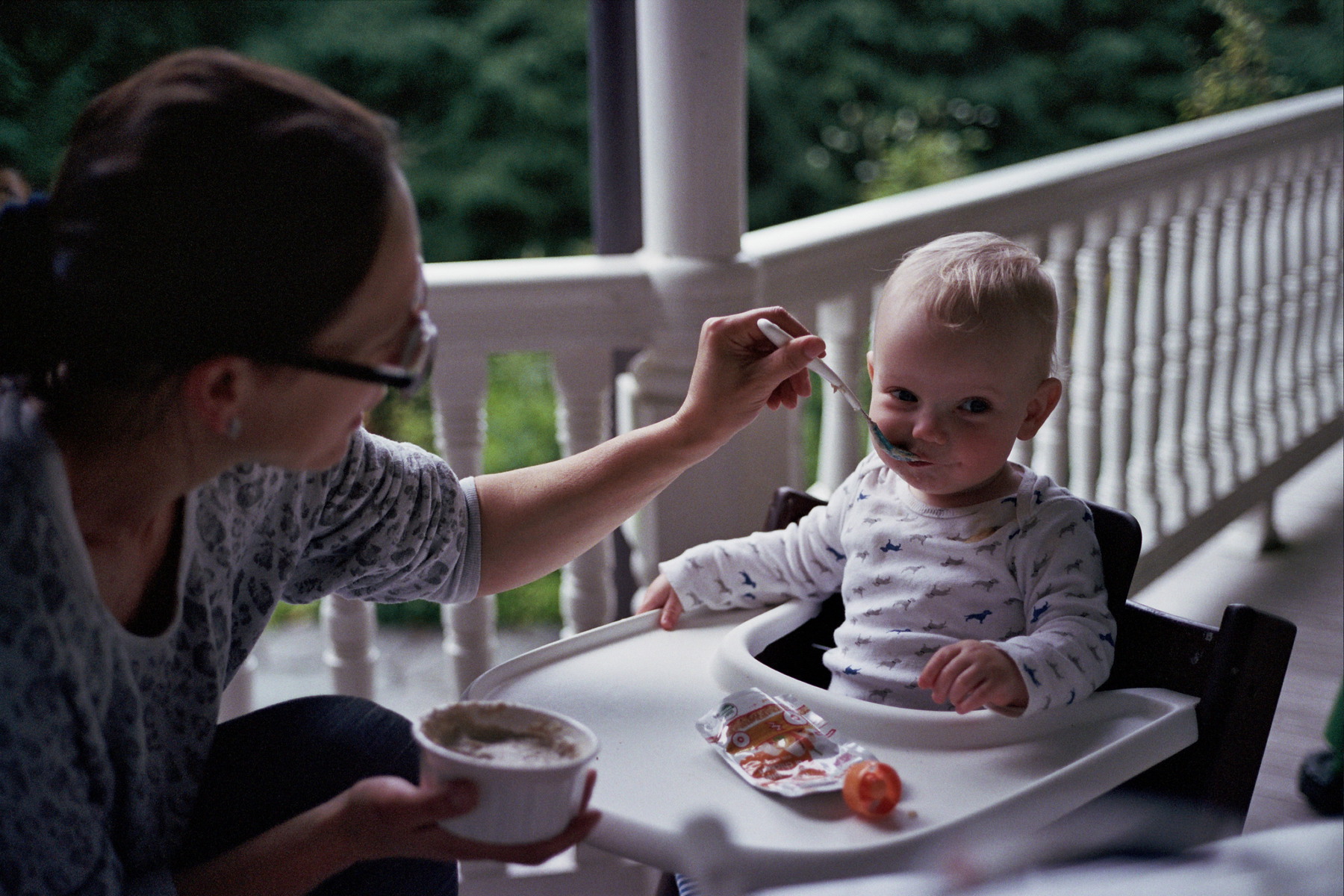-
My Favorite Clickety-Clackety Keyboards
Clickety-clackety keyboards are the best keyboards, but they annoy other people. So you need to be able to swap out something your daskeyboard (with all black keys, no letters on them1) for an Apple Magic Keyboard (the black version). But what if you want even more clackety…

The Mattias Tactile Pro echoes like the feeling of hacking into a mainframe in 1986 with Matthew Broderick looking over your shoulder, eyes wide, mouth slightly open, rubbing his fingers together, anticipating the very moment when BAM! SYNTHESIZERS!

WE’RE IN!
Sometimes you want to really work out your fingers and make little snapping sounds, with every keypress SNAP, SNAP, like you’re SNAPPING the letters and words together with little snap’n’pop firecrackers you hurl at the page. The Underwood Champion is for you… Champion.
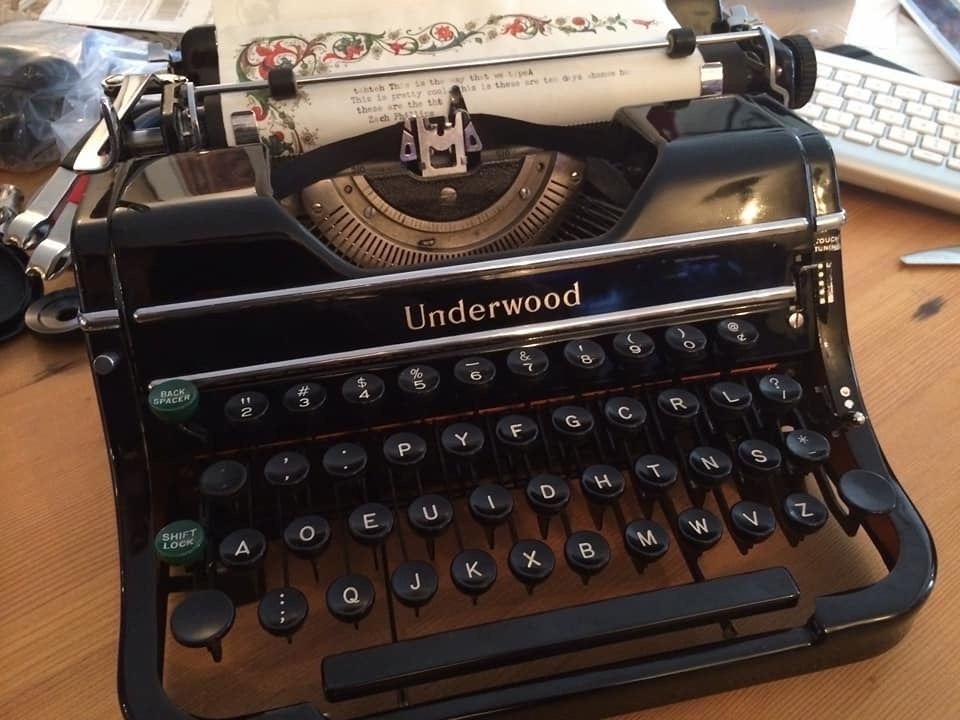
But when you really, really want the clickety-clacketyest keyboard of all, you switch to this one… It’s like firing a machine gun. No one can deny you are WORKING. VERY IMPORTANT WORK. I made a video some years ago about another magical thing it can do (sorry for the dated music):
You have too much self-respect to accept without scrutiny the keyboard that’s issued with your computer. There’s too much clicketyness out there in the universe…
But probably keep your Apple Magic Keyboard (the black version) for calls/not making everyone around you hate you.
- You’ll need to put some tape over the ugly-ass logo, but the switches are ktink, ktink switches, they rock! [return]
-
Hamburgerification
I don’t remember where I heard this, but something like “If you want the best chance of being successful in business, you should sell hamburgers. People will always buy hamburgers.”
So the bulk of our smartest minds are currently focused on turning everything into hamburgers.
The big problem with focusing on Hamburgerification is that focused attention is a limited resource. Every moment you think about how to turn something into a hamburger is a moment that you aren’t playing, mastering a skill, cultivating empathy, connecting with other humans.
As an early employee at Facebook said: “The best minds of my generation are thinking about how to make people click ads.”
“How can we turn XXXXX into a hamburger” is a very specific problem. It demands a very specific type of thinking.
There’s nothing wrong with pursuing a scalable business. I’m currently doing one myself. But not all businesses can or should be about massive scale.
But when all you have is a billionaire-or-bust sledgehammer, everything looks like a hamburger.
-
Writing Exactly Wrong
I offended some people I care about with this post from last week. I’m sad because the way they read it was exactly the opposite of how it was intended. This means I wrote it exactly wrong.
This may be a problem with publishing every single day that needs adjustment.
My purpose in writing this post was to show how my mistrust/doubts of my own feelings and experience has been hugely unhelpful to me. On top of avoiding/not paying attention to my feelings, when they’ve gotten too strong to suppress, my next defense was judging/dismissing them.
Then I wrote the following, and the way I wrote it I realize now was careless and hurtful.
This is one of the reasons in the past I’ve been skeptical of some mental illness. Like, is this Depression? How depressed? Depressed enough to miss work? Depressed enough to get medicated? I can see how talk like this can be offensive to sufferers but I’m legitimately baffled.
The voice in these paragraphs is myself in the past, doubting how to measure my own feelings, my own pain. The point of posting this is to share that I’m no longer baffled.
I thought I was making my intentions clear two sentences later—
Two things have helped me begin to get over this (unhelpful) frame…
—but I had already lost some with my prior clumsiness.
I’m someone who has struggled heavily with my own psychology (18 years sober, 20 years in therapy, a library of self-help books, a staff of coaches) but I’ve never been diagnosed with DSM mental illness. I should have left that term out completely. I’m talking about feelings.
When I discover I’ve been wrong about something, I feel this incredible need to share how wrong I was in a way that might have convinced Confused Me earlier. Waking up to the fact that feelings might be important in my mid-thirties has me wanting to shout from rooftops.
But when what I was wrong about implicates a lot more than myself, I better make sure I at least do a proper revision and check it with someone else first.
Thanks for bearing with me.
And MY GOD I have to stop with the all caps stand-in for italics on Twitter. I’m a guy who needs italics, so Twitter friends will just have to tolerate Markdown style italics. Apologies for all the underscores.
-
The formula for how much I will like an old broadway or movie musical is equal to the number of tapdancing songs divided by the total number of songs.
Where’s the show that’s just tapdancing numbers all day?
-
Italics for World Peace
Creative constraints are helpful, but for platforms like Twitter or Facebook not to have italics is constraint run amok. In fact, I think this lack of italics has substantially contributed to the toxic social media environment.
No italics leaves you only ONE OPTION.
The big problem with ALL CAPS is that it’s at least 7.2x more aggressive than italics, but without italics, it’s really your only option other than plain text Markdown styling. And most people don’t know plain text Markdown styling.
SO IT’S ALL CAPS ALL DAY.
Now all you fancy writerly people who think that italics, like exclamation points, are for losers, or overused, or whatever… look, most people aren’t fancy and writerly like you. We write more conversationally. Italics are helpful to us.
Italicize any word in “I didn’t say she stole my wallet” and the sentence takes on an entirely different meaning (and when all you have is ALL CAPS for emphasis, it’s impossible to emphasize the “I” in that sentence, just saying).
It already takes a lot of effort for most of us to get our point across in writing. When you make us shout every time we just want to emphasize a few words, you’re raising the temperature in the room.
Adding italics would bring down anger at least 4.8%.
Italics for world peace.
-
Character Craft
When writing stories, at least for me (and maybe I’m doing it wrong), I’m usually thinking about concept/theme first, not characters.
While the strength of the characters is the most important thing, it’s usually not the first thing and this can be tricky to navigate.
A story’s concept/theme can feel so clear and decisive like “YEAH, it’s a zombie movie but with no zombies, and it’s about a virus that causes people to lose control of their rage, and it’s ultimately about notions of free will and culpability… We’ll need some good characters!”
Characters are hard for lots of reasons. While I find it effortless to write interesting, dynamic supporting roles, my protagonists are usually boring and sucky. More on that another day.
But my confidence really drops when I think “Shouldn’t I have started with characters?”
The thing about a lowercase-s story is that it’s linear, time-limited, and self-contained. Those are really helpful constraints.
The thing about a character is that it’s a person. Wicked complicated, unbounded, impossible to pin down.
I can craft a story with compelling themes and rising tension but none of it matters if no one cares about the characters.
I think I need to stop thinking about characters as “things” I’m “crafting.” I need to treat them as if they’re all already here. Because they are.
Every character that I’m able to channel in imagination or on the page is a character that’s been with me, grown with me, and is made up of bits and pieces of everything I’ve ever experienced, everyone I’ve ever met, and the way I interpret what they’ve experienced.
Rather than trying to define my characters, forcing them into my little dramatic devices so that they can grind my axes for me, it works much better when I simply ask them what they think, what they would do, and then just listen.
-
I often find myself copying things from Roam into the Substack editor just to copy them back out. Almost everything formats properly when I do this. It would be siiiiick if we could get that functionality from Roam by itself.
-
Lost Words: Multimedia
There are many examples of words that are ruined long before they actually become useful to describe something.
Today, let’s talk about “Multimedia”!!!!! 📽️✍️🎙️🌈….. 👇
The word “multimedia” calls to mind a CD-ROM, the kind that you had to mount inside of a little beige plastic caddy before inserting it into your Macintosh Quadra.
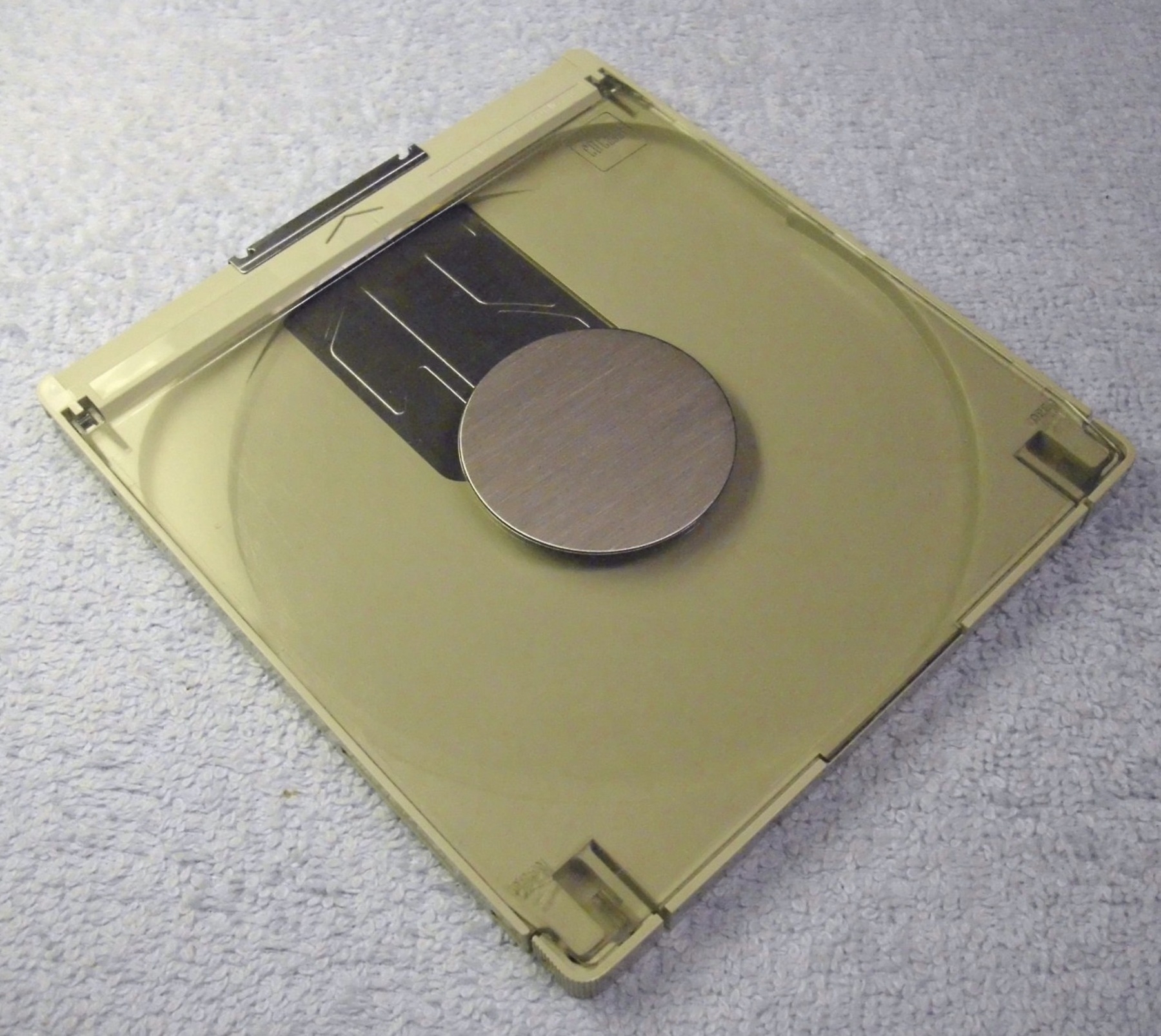
At that time multimedia generally meant “words AAAAAND pictures and maybe SOUUUUUNDS all on ONE THING.”
Later on “multimedia” became a catch-all word for anything that someone might make (like the awful word “content” is used today).
Some tools (and words are just tools) need to sit around in a drawer for a few decades before we find a good use for them…
As the world becomes more conscious of accessibility and the fact that different people learn in different ways at different times, the word “multimedia” finally has a good use: Much of what we make is published across multiple media. Prose/Film/Radio is the most common combo.
A note on multimedia work: Translation between media shouldn’t be automatic. Some thought should go into how something is best presented in each medium, even if sometimes it’s as simple as a text-to-voice, voice-to-text, or just saving out an audio version of a video.
Many works are single-media-only and they must be. There’s no clear film version of most radio stories just as there’s no prose version of a great film.
This is multimedia.
But there can always be a radio version of prose or poetry. 98% of YouTube videos could just be audio.
But because the word is ruined, we’ll need to use a word like multiformat, which I don’t hate, but—
It shoulda been you, multimedia… It shoulda been you.
My next experiment on my little blog is to begin making these posts multiformat.
-
The Original Recipe™ Process: Purpose
Today I’ll be going into some more detail on the first ingredient of story we measure in the Original Recipe™1 process: Purpose
You might be surprised how many marketing/video/storytelling endeavors begin without a clear Purpose.
Purpose has two sides. One is “our” side: “Why are we telling this story? What are our objectives?” Answering these questions is a helpful exercise. Believe it or not, this is often glossed over.
The other side is your audience’s side: “What is this thing? What’s the point?”
All story ingredients have a dark side and Purpose is no exception. The “market” dark side of Purpose is why every movie is a sequel or reboot of something someone wrote more than 50 years ago.
The best predictor of a movie’s success is if the audience knows “what it is.” 🤷♂️
When the financial risks are as high as they are in filmmaking, of course all movies will default to Lego Batman Star Wars (but Frozen).
The non-dark side lesson we can take from this is that it’s super important that our story’s audience has a sense of what it’s “about.”
The Purpose ingredient is where I personally measure a statement like: “To convey our company’s serious investment in sustainability, we’re telling the personal stories of those most affected by environmental damage. By giving them a voice, we show (don’t tell) our commitment.”
For each story ingredient in the Original Recipe™, I’ll provide examples at the extremes: What happens if a story is only Purpose and what if a story has everything but Purpose?
A story that only has Purpose but no Authenticity, Conflict, Spectacle, or Novelty is an infomercial: “We want you to buy this thing. This story is about buying this thing. We’ll use every tool (as long as it requires no effort or imagination) to get you to buy it. Buy it. Buy it. Buy it!”
A story that has Authenticity, Conflict, Spectacle, and Novelty but no Purpose is arthouse cinema material. It may be beautiful and nuanced and amazing, but it probably won’t be very useful for any marketing purpose.
Each story ingredient has at least one balancing ingredient that is most affected when it dominates the recipe.
Purpose’s most prominent balancing ingredient is Novelty. See Hollywood for the best example of an overemphasis on Purpose squeezing out all Novelty.
Purpose is the first ingredient of the Original Recipe™ for a reason: It’s the most helpful to think about first, it’s the easiest to take for granted/not spend enough attention on, and it’s the ingredient that most affects whether an audience entertains your story at all.
-
Being My Own Client
I’ve written thousands of pages of messaging for clients, fighting for what I think will be best for them and finding a place where we’re both happy in a reasonable amount of time.
Writing messaging for my own thing is so much harder, precisely because it’s less constrained.
A great irony is that a common refrain from Creative Professionals Who Give A Shit™ is “if the client would only let me do what I think is right here, it would go so much better for them,” or put another way: “Give me a sword, I’ll win this war for you.”
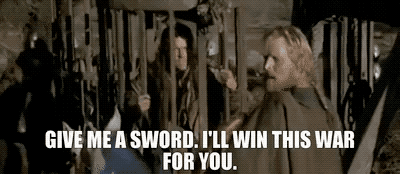
In fact, constraints are the single most liberating factor of any creative endeavor. A client to make happy before a deadline is a perfect constraint. This may be why many people like me have so much trouble creating our own work but can be absolutely prolific for customers.
Today I’m consistently producing words/stuff for myself, just for its own sake. It’s working.
Now there’s an important bunch of writing to do “for work,” only “the customer” is me, more or less. This feels hard.
While it feels like I could just add a constraint like a deadline (which I have) or a promise to someone else (which I have made), the problem is that the constraints need to be “real” and not purely coercive.
The curiosity prompt: How might I do this for its own sake?
-
Poems and Flowers
I don’t do enough special things for my wife. I know this isn’t a rare problem, particularly when children are small, but now that I’ve proven to myself that I can write lots of words every day, I can surely at the very least write a poem for her on Valentine’s Day.
I wrote the poem, a short poem, and I most definitely won’t be sharing it with anyone but her. I think she liked it.
Here’s the thing: I should probably have gotten flowers too, but I’ve always felt weird about doing standard, expected things. Sincerity is important to me.
I’m not what you would call a Christian, but my wife is, and when we got our daughter baptized, there were certain rites/prayers to say. I made sure to meet with the priest because I needed an explanation of what each of the things I was saying meant.
This isn’t because I feel like being insufferable about my religious beliefs and non-beliefs. It’s because I see something like a baptism as a very important ritual, and I don’t want to taint the ritual by doing something phony in the middle of it.
When I was in college, I attended more than 100 weddings (as a photographer/cinematographer), and most of them were Catholic for some reason. Probably 80% of these couples either lied to the priest or during their vows, and I’m being conservative with this estimate.
I’m all for a harmless lie to smooth things over or avoid a needless confrontation with a religious grandmother or somesuch, but to lie during the vows? It’s crazy to me: This moment that’s designed to be an earnest declaration of lifelong devotion, we slip a lie in there?
Anyway, maybe I’ll get her flowers next year, but I doubt I’ll ever feel a fraction as good about the flowers as even a five line poem that took 25 minutes.
I like rituals. A lot. I care about them too much, in fact. That’s why I experience so much resistance to rote ones.
-
The Lonesome Valley of Change
Yesterday, a day “off,” I elected to reorganize my office. REALLY reorganize it. I should be able to reach out and have precisely the right tool to do whatever I want with zero friction.
So I emptied every drawer and shelf.
I am in the in-between now: The Lonesome Valley.
This is the problem with changes/improvements to calcified layers of standard operating procedure: Even if what you’re currently doing is really not working, once you enter The Lonesome Valley, everything you know is thrown out and you’re overwhelmed.
In The Lonesome Valley, you don’t know where anything goes. Every item you come across raises a hundred questions you aren’t prepared to answer yet. Everything is out of context, familiar but starting from scratch.
It doesn’t help that every single step I get stuck on one thing that I just know I have but seem to be missing. This could be an attention deficit thing but more likely it’s just a way of clinging to something/anything solid, known, decided upon.
The way I’m dealing with this reorganization right now is by writing down what I intend to do on paper. This drawer is for this kind of item. This area is for this kind of activity.
Really hoping I can feel some progress in the next couple of hours.
While others can be supportive, The Lonesome Valley is something you will need to walk alone.
No one can tell you how much you’ll need to give up in order for your current patterns to achieve escape velocity and be free to reorient themselves to a new gravitational alignment.
Related: No one can tell you just how much you’ll need to slow down the guitar notes to where YOU can’t even recognize them as part of that song you play (with bad habits) anymore.
I leave you with some of the only known footage of a true legend:
-
Teach a Man to Fish (but really)
The “teach a man to fish” thing has been claimed more often by a conservative “helping people is actually bad for them” ideology than by any other. The irony is that “teaching a man to fish,” in any form, is incredibly expensive. Conservatives are almost always the least willing to pay for it.
Let’s first remove any condescension from “teach a man to fish,” because this is very important to understand: Literal fishing is actually pretty tricky business. If you were trying to learn to fish from scratch, with no resources, you very well might die before eating any fish.
Fun fact interlude: Fishing is arguably the most popular “complicated thing” besides cooking that Americans do.
Surprising stat of the day:
— Ian Sigalow (@Sigalow) August 24, 2020
49 million people in the US go fishing each year.
More people go fishing than go biking (47.5 million bikers)
Fishing is more than twice as popular as golf (24 million golfers)
To understand this is to understand America.And “teaching a man to fish” is far more profitable if you teach him to fish for you so that you can sell the fish to everyone else. Fish interests within our economic system (Big Fish, as opposed to Big Fishing) actually benefit from fewer people knowing how to fish.
Let’s extrapolate “teaching a man to fish” out to something far more complicated than fishing: Navigating our economic system without familial wealth, class status, or education opportunities.
This requires serious investment of time (which we’ll need to pay someone for).
Faced with the reality of the investment required, the first people who opt to throw fish at the masses are conservative-minded “government is bad” folks. It’s far less expensive in the short term to just give people fish, especially when there’s so much fish lying around.
Again, I want to be really sensitive to precise flavor of condescension here. In fact, the true condescension contained in the usual presentation of “teach a man to fish” is the baked-in assumption that teaching fishing is easy, not that fishing itself is easy.
When you’re born with a resource, you certainly devalue it, but you devalue the work necessary to acquire it even more:
“How hard could it be to teach someone to fish? I was fishing when I was 7.”
Better question: “How many hours of focused attention did my grandfather spend teaching me to fish? How much was the pole? The ride to the lake?”
How much harder is it to teach a man to fish than to give him a fish? Depends on the price of a fish. Potentially a million % harder.
Until we’re willing to spend the time (money) to teach people, really teach them, how to navigate the incredibly complicated challenges that our powerful classes assume are no big deal, we’ll just keep fighting until the endtimes over how much fish to hand out.
-
How Do You Know How You Feel?
I’ve spent my life incredulous of people who can state “how they feel” with confidence. I realize now it’s because I never learned to trust, or even pay attention to, my own sensations: physical, emotional, otherwise.
MOST PEOPLE I’m feeling XXXXX
ME But how do you KNOW?
Just as every grade-schooler ponders whether “you see green the way I see green, what if green is actually purple to you?” I always had a similar reaction to feelings… Is this sadness? And how much?
“Can you rate the pain from 1 to 10?”
But what if I’m a wimp? Or what if I’m super tough? How do I know if this is really bad pain or just whatever pain?
This is one of the reasons in the past I’ve been skeptical of some mental illness. Like, is this Depression? How depressed? Depressed enough to miss work? Depressed enough to get medicated?
I can see how talk like this can be offensive to sufferers but I’m legitimately BAFFLED.
If I’m the only one who can experience my own experience, how can I measure how it compares to others’, much less to some shared standard?
Two things have helped me begin to get over this (unhelpful) frame…
The first thing that’s helped me is accepting that every decision is made with incomplete information.
Example: “Do I know if this is real pain I’m feeling and is it a lot? I don’t KNOW but it’s wicked uncomfortable and it FEELS like lot.”
Proceed like it’s a lot of real pain.
The second (very important) thing that has helped me is accepting that NO JUDGMENT OF FEELINGS HAS EVER BEEN HELPFUL TO ME IN ANY WAY.
Example: “This feels like a lot of pain, but it’s probably not, because this shouldn’t hurt that bad because—“ PEACE.
I also realize that on some level these reflexive judgments of my feelings weren’t much more than a strategy to suppress them. A deeply ingrained, problematic suppression strategy, but a suppression strategy nonetheless.
It definitely doesn’t work, by the way, suppressing them.
-
Introducing The Yaklog
Yak shaving has a presumed negative connotation, but most in the Eternal Order of Yak Shavers truly enjoy shaving yaks.
But not all Yaks have that luxurious, sumptuous hair that truly satisfies a Yak Shaver. These should be immediately relegated to the Yaklog.
The problem with yak shaving isn’t any particular yak or even that we put yaks between ourselves and our deepest desires. The real problem is when a yak just isn’t a good enough yak and we still allow it to stand in our way.
Before I “completed” my blog, I suddenly realized I needed to have footnotes. Beautiful, luxurious footnotes that were clickable inline, could be typed inline in MultiMarkdown, could contain rich media… And of course, I needed to finish this before I could publish on my blog.
Those footnotes are goddamned delicious, like a fresh ear of Silver Queen sweet corn rolled in salted butter 7 ½ minutes out of the boiling pot and less than an hour from being picked off the stalk. I mean just CLICK the footnotes on this post.
Those footnotes are the kind of yak that a Yak Shaver can shave with deep pride and self-assurance. Once you realize they are possible, they become necessary, you see?
Then I decided that, before I could post on my blog, I wanted it to have a native Dark Mode…
Now, the native Dark Mode on my blog is cool (it’s in the hamburger menu), but this was not a yak that needed to stand in the way of posting to my blog. Dark Mode was definitely a yak for the Yaklog.
The absolute worst thing you can do is put Yaklog-worthy yaks into your Backlog. Filling your Real Tasks with mediocre yaks is a surefire path to total breakdown. I have burned many carefully scaffolded task systems to the ground when they became lousy with middling yaks.
When do you get to the yaks in the Yaklog? Whenever you want!
Now this can be tricky, as Yak Shavers rarely know what they want. They’re too stuck on what they need.
The only time you can’t work from the Yaklog is to unblock you from doing something you want to do.
Remember, the fact that the yak was moved to the Yaklog means that it was never really a very good yak in the first place. Yaks like these aren’t worth holding up anything to shave. They can be shaved for fun, for an experiment, for curiosity. But not for any other task.
If you’re currently shaving a yak, no matter how luxurious, of course you must finish. Leaving a yak half-shaved is disrespectful. This as a “Yak In Progress” or YIP.
If you’re stuck on a yak, you’ve “got the yips.” We understand.
Finish shaving. Then you can start your Yaklog.
-
Security Theatre and Evidence That People Are Good
Warning: This thread is intended to make you feel better about humanity, but it could have a different effect: It could make you feel scared. So if you’re someone who obsesses about danger, maybe don’t read this thread.
I also want to acknowledge there are so many people who have been physically hurt by other people. It’s not my intention to minimize that, particularly because I’ve had only a few experiences being physically attacked.
I’m talking about specific obsessive fears in the culture.
Airports have a lot of “security.” Lots of buildings have “security.” Your door has a “lock” on it.
Here’s the truth: If someone wants to hurt you enough, they’ll figure out how to do it. Absent a bodyguard (hell, even with a bodyguard), you’re dead.
This is good news!
Think about it: Even with every terrifyingly tragic mass-shooting event in recent history, the fact that almost all of the 7.5 billion people in the world aren’t planning ways to hurt others is a really positive sign for humanity.
Either that or the violent ones are super dumb.
You’d have to be stupid if you couldn’t figure out how to commit a really upsetting atrocity, particularly with all the tools available (especially in America AKA the Ocean of Guns between the Atlantic Ocean and the Pacific Ocean).
Looks like people just don’t want to hurt us!
The perpetrators of mass atrocities sometimes get called “masterminds” and it’s just dumb. Pretty much every sick violent thing that people have done outside of war has been really damned simple.
It doesn’t take a mastermind. It takes a particulary kind of sociopath. A rare one.
Anyway, I’ll keep locking my door and having means to defend myself and my family (not comfortable with guns…), but I’m not going to kid myself that I’m defending against capable people who want to hurt us.
At best, I’m defending against idiots who might randomly crash into us.
I’m not saying there aren’t really dangerous people out there. But the fact that it would be SO EASY for anyone to do something terrible, yet hundreds and hundreds of millions of them aren’t doing it, is more hopeful than if they weren’t doing it because of some security theatre.
There seems to be an extremely small number of people who mean us harm. The more we take care of each other, the fewer there will be.
People are basically good. Even our fear of them is evidence of goodness (we mean to protect one another from harm).
This is a hopeful thing.
-
A Commitment to Publishing and Why
Tomorrow I’m speaking to the current cohort of James H. Gilliam Jr. Fellows.
Presumably I’ve been asked to speak because I’m an expert at something, but experts usually aren’t the best teachers, so I’ll speak on something I’m a novice at: A commitment to publishing and why.
I’ve only been at this publishing stuff for less than a year, but it’s the best thing I have to offer. And because it’s fresh for me, I’ll be better at transmitting the experience. I’ll also be proving the metapoint: YOU have something to offer, new as you are (as I am).
One of the things I wish I’d been taught when I was much younger, though I probably wouldn’t have listened (in fact I was certainly taught this and said “I’m good”) is that publishing Quantity, for its own sake, as much as it hurts me to admit, is the One True Path.
Now I don’t mean just any old Quantity. It needs to be Sincere Quantity. But, critically, it does not need to be Good™.
Aim for Good™ and you’ll ironically get less quality because you’ll produce less.
Aim for perfection and you’ll get NOTHING AND ALSO MAYBE DIE.
What is Sincere Quantity? Basically, it just needs to be genuine, authentic, from you. That’s all.
This is tricky in a culture that is pathologically incapable of sincerity, but it isn’t hard. Just publish what you are thinking about as your earnest self (or pseudonym).
One video that’s gone around in the last week is Marques Brownlee’s 100th YouTube video from 2009. He had 74 subscribers.
Today, he has 13.6 million.
But even if today he had 74 subscribers, publishing would STILL be worth it!
One of the great ironies of this digital world is that while we’re very much “in contact” with each other, and through TEXT no less, we don’t actually write to each other.
A lot of our historical record is made up of letters written between people. That’s lost for most of us.
Write a couple of letters to people you care about and you’ll immediately see how it helps you discover what you actually think, what you actually want, and pathways to new/better ideas.
If you’re publishing to only a handful of people (or even one), you get these incredible benefits. Journaling is also important and great, but there’s something about pressing Publish that’s different. It’s saying “this one’s done, on to the next one.”
You kill a LOT of birds with one stone by publishing: You create something that might be useful to others, sparking their own ideas. You relieve your mind, soul, even your body, of tension. You open avenues to new relationships and opportunities.
Concerning yourself with “success” through publishing (in the form of money or fame) is a sure way to publish nothing (and certainly nothing sincere). But just publishing your work somewhere, in a place that you own, for its own sake, regularly, will probably transform your life.
As someone so concerned about quality for so long that I made bits and pieces of hundreds of things that I never shared with anyone, I regret that my mindset wasn’t Just Press Publish from the start.
-
The Want/Must Matrix
Today I had this perfect set of tasks that fit neatly into all four quadrants of an idea I’m playing with called the Want/Must Matrix.
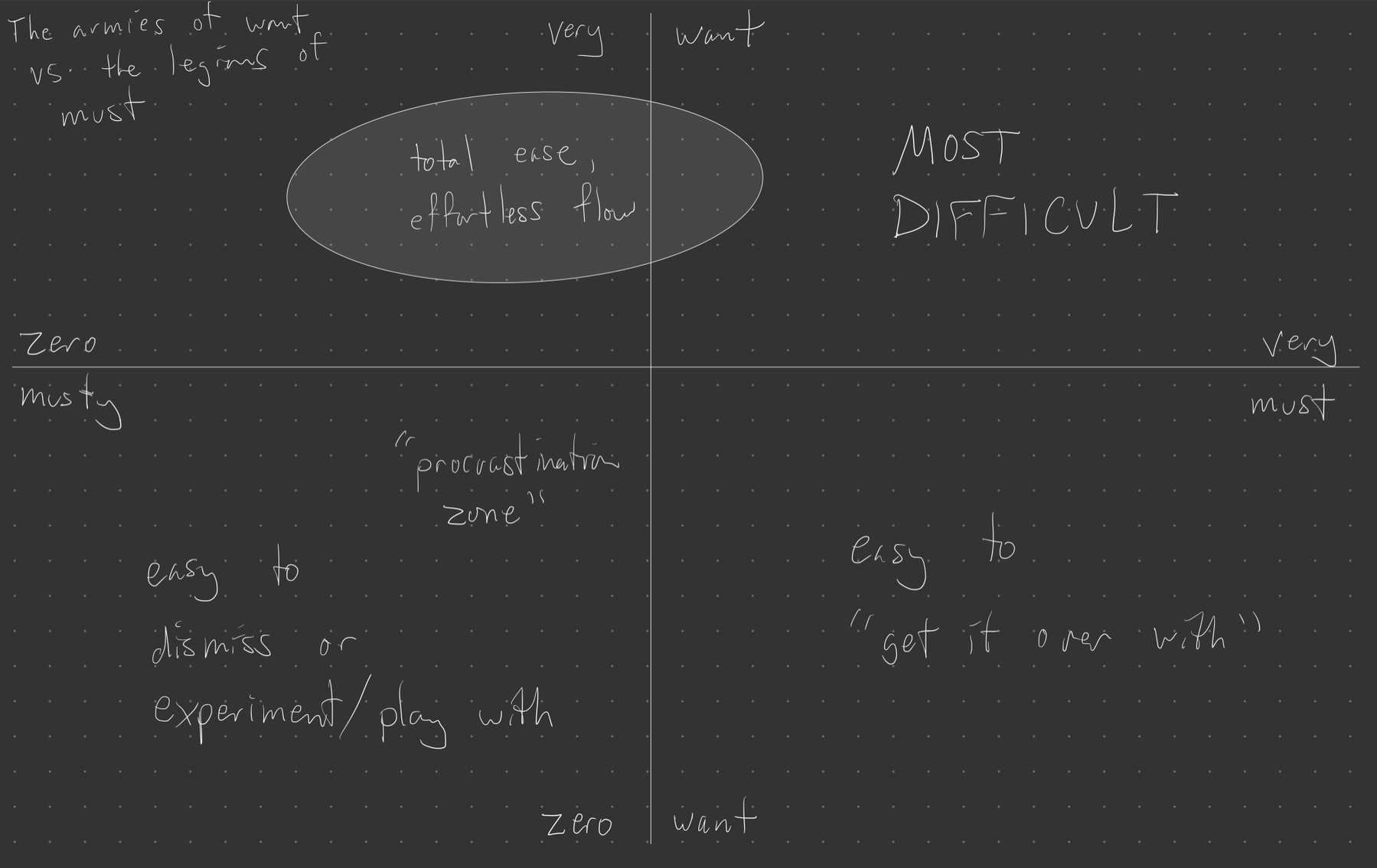
The counterintuitive thing I’m arguing is that the tasks that create the most resistance are those we both MUST do and WANT to do.
Common productivity advice when you want to do something but have resistance: “Find a way to force yourself through public accountability, promises to others, etc..”
Softly/playfully, this can help, but when taken seriously, it’s the perfect recipe for procrastination.
When we procrastinate, we’re usually avoiding something that we must do in favor of something we want to do. Right?
This is exactly wrong.
We’re often avoiding the things we most want to do in favor of things we neither want nor must do. 🤦♂️ Why do we do this?
The most common procrastination activities are usually no more than tics disguised as Wanty or Musty or some combination. We spin artificial webs of want/must/must-want to distract ourselves from the discomfort of the friction between obligations and our true desires.
We check email ten times, organize stuff. If we play a game, we do so with a sense of duty (“just need to finish this level”). We aren’t “playing” at all. This isn’t the romantic procrastination we were promised!
Why would we do these things in lieu of what we most want?
If our obligations and true desires are perfectly in line, why wouldn’t that be advantageous? If we get to do “what we love” for “our job,” isn’t that ideal?
Ask someone who has made their “passion” into their “job” and see how smoothly it’s gone for them.
The most common explanation for this incongruity is that we’re somehow afraid of failure and so we don’t start. Sure we’re afraid of failure, but fear of failure is insignificant next to the true cause of the really bad resistance.
The big cause is adding more Must to our Wants.
The great paradox is that, if you Want to do something, adding Must to it adds resistance. The part of us that Wants (and always knows how to do the things we want, needing no help) is completely gummed up by the part of us that tries to coerce and control it.
If you think I’m talking only about work, I’m not. This applies as much to reading or playing with your kids. We have an incredible knack for making anything into an obligation, and when we do, even the thing we want most in the world becomes a massive struggle.
Our coercive/extractive cultural discourse says human behavior is “lazy” or “not lazy”. “Good” people do what they must, and “bad” people do what they want.
This doesn’t hold up. People who do the most are people who have figured out how to do what they want to do with ease.
Learning to do what we want to do is less a process of learning as it is a process of _un_learning. We already naturally know how to do what we want. My 3-year-old never needs to ask herself what she wants to do or try to motivate herself to do it.
“But your 3-year-old doesn’t have real work to do.”
Irrelevant. She begs to help with everything: dishes, cooking, picking up. She’s just not good at these things yet.
Some of the most satisfying work I’ve ever done was cleaning a restaurant kitchen at 1AM or shoveling stone.
There’s nothing precious about the work it takes to write your book or app. It’s no different from stacking firewood or doing dishes. /your thing/ is just something you want to do that you’ve made so Musty that you can’t even access the part of you that wants it anymore.
All Must isn’t bad. A bit of Must can appetize Want/Play. But the Must can’t have judgment attached. “I must post a thread today” = ok. “I must post a GOOD thread today” = dead.
“This better be good” or “You’re in trouble if you miss this deadline.” Not helpful. Not once. Ever.
And the Musty voice needs to fade into background noise if you’re going to actually do/enjoy doing the thing.
The only way for that to happen reliably (Flow) is to actually stop believing that you need the Musty voice. To believe that, you’ll need evidence.
This is proving to be a pretty wide-ranging topic and I’m not going to be able to encapsulate it in one post/thread nicely the way I wanted to. But that’s okay, because there’s nothing about this that I MUST do other than post it, which is fun.
It’s fun to post every day.
Oh, oh! One more peculiar thing on the topic of procrastination:
In The Want/Must Matrix, it appears that procrastination can only happen diagonally. You can only procrastinate with stuff you actually want to do if you’re avoiding stuff you have to do but don’t want to do. 🤔
If you smell something musty, turn around.
-
Filmmaking in Public: A "Zombie" Series Concept
I’m fascinated by the implications of free will (and whether it is in fact just the last bastion of magical thinking). The story of the Texas Tower Sniper, documented through his own writing, is unbelievably chilling.
I’m sketching out a “zombie” series that explores this. 👇
Series concept: There’s a virus that produces no felt symptoms but it removes the infected’s ability to control their rage if triggered in some way. As it spreads, it creates otherwise normal people who are walking grenades waiting for the circumstance that pulls their pin out…
My friend and colleague Jason and I discussed the opening scene of the pilot before doing some storyboarding this week in Storyboarder VR:
The series as currently sketched will follow investigators as they try to figure out why there are these aberrant violent crimes coming from people who don’t fit the profile.
Spoiler alert: Eventually in season one, our main sleuth discovers they have the virus.
I usually name projects before I start them, and I love naming things, but for some reason I haven’t come up with a name for this series yet (open to freely-offered suggestions). I’ll be doing this filmmaking in public. The first goal: Make the pilot in Storyboarder.
-
The Netflix Envelope and Removing Friction
Netflix had to make lots of good decisions to get to where they are, but the most critical—the linchpin of what is now an empire, was the design of the Netflix envelope.
To start anything new, you have to remove friction. Precisely how much you have to remove is unknowable.
Whether you’re trying to sell a new thing, change a behavior, or improve the world, the question that you need to return to over and over again is “How can we make this easier? More frictionless?”
It requires sensitivity to discover the deepest, most entrenched friction.
The most difficult friction is completely hidden from us. We’ve just accepted it as reality, a la The Matrix. You won’t discover this friction through focus groups or A/B testing.
In 2006, almost no one thought they wanted a touchscreen keyboard, yet literally everyone did.
The best way to discover these hidden points of friction is to be sensitive to your own negative feelings: anger, fear, anxiety, sadness, frustration, even violence.
The most successful change agents are deeply attuned to how much—and _why_—they hate the status quo.
We need to accept these points of friction as legitimate, as solid as a law of physics. They cannot be dismissed as stupid or unreasonable.
How big a deal is it to get a stamp? Well, Netflix’s current market cap is 243 billion dollars. Finding a stamp is a pretty big deal.
The energy to push through physical or psychological friction is a finite resource like any other.
The moment the price of a barrel of oil rises above a certain threshold, legions of humans and machines instantly and violently start exploding stone to release natural gas.
If you have an intuition that something should work but it isn’t, sit quietly. Your intuition is likely right, but the solution subtler than your awareness.
One thing is certain: Force amplifies friction. It may work once or twice but it can never create sustainable change.
We need to remember: Whether we’re hawking our wares or making the world a more just, kind, and equitable place, we are the ones with the agenda. Therefore, it is incumbent upon us to make change easier for those we want to change.
It doesn’t matter how right we are.
We are surrounded by useful, potent structures that are rendered completely ineffective (or massively harmful) by minuscule points of friction.
Our politics, commerce, and change discourse is all shot through with brute force methods.
How can we make it easy to change that?
-
Getting Real Value from Walled Gardens
As we move to destroy monopolist walled-garden “web” vampires (don’t worry, we win in the end), we can and should meanwhile use their constraints to benefit ourselves and one another.
Here are some social media platform constraints and how we might get value from them.
First, Twitter: 280 characters is a helpful constraint for writing, even long(ish)form threads, where each section needs to stand alone and contribute to the larger idea.
Also cool about threads: reference/discovery via different “entry points.”
At the moment, all of these microblog posts are started as Twitter threads, composed in Roam using the character limit feature. I try to keep them all at 13 tweets or fewer.
Twitter also seems to be the absolute best place ever created for finding people with similar interests, no matter how niche.
Keep the original text of any tweets you care about in data that you own like a @microdotblog or your @RoamResearch graph.
The most important constraint of Twitter (that applies equally to all of these “platforms”): It’s a trash heap owned by someone who doesn’t care about you. Nothing in it matters other than being a decent human being.
To be clear: All of these platforms are owned by nihilists.
The social media companies would feed your children to piranhas if they thought it would improve Engagement™.
Don’t hang ANYTHING important on your identity as expressed through one of these platforms. It doesn’t belong to you, nor will it ever be offered for sale (to you).
A core principle in using all of these vampire platforms: As long as you’re having fun and keeping ownership of anything valuable you create, you can’t do it wrong. Use these dystopian hellscape fiefdoms as your personal playgrounds. Never take them seriously, even for a second.
Facebook Groups can be useful for finding people around a specific topic (because all forum software has failed), but for publishing, Facebook is likely the worst product ever created by mankind. Get your relationships off Facebook and into a Personal Email Newsletter (PEN).
Instagram: Nearly completely worthless. This is a company that hates photography and photographers. They mangle every photo you take and don’t even let you leverage their platform for a single good or healthy thing for yourself. They should be the first to be thrown into a fire.
That said, Instagram groupings of 10 photos (all at the same aspect ratio 🤦♂️ and mangled to hell by a company who hates photography) can help you edit.
Keep photos in similar groupings in Photos/Lightroom while we wait for someone to (finally) create good photo hosting.
YouTube might be the most problematic of all of the platforms precisely because it’s the one that seems to provide the most value to its meat I mean users. It got here by way of the accident of file sizes/hosting costs. Thank God podcasts skated in under the copper limbo wire.
YouTube is the most entrenched monopoly of all the vampires. I need to think more on it, but right now I think it should just be treated as Twitter for video. Always have a version NOT for YouTube, without “like/subscribe” garbage, unless it’s something you don’t care about.
I don’t have much to say about TikTok. It’s just videos of arbitrary length/orientation/aspect ratio. If you want to tell stories/jokes concisely, TikTok is great for experimenting, but you should own those videos and put them anywhere you like.
TikTok should be algorithm-only.
I’m not a gamer, so I have little to say about streaming at the moment, but I’m testing it out over the coming weeks with some filmmaking in virtual reality.
Snapchat/Instagram Stories/Facebook Stories/Fleets: These I find really interesting, because the impetus to share a moment from your day that self-destructs might in fact be a most excellent prompt for JOURNALING. I’m in favor of journaling, no matter the form, but save every little moment in your own place too.
I’m very curious what other value people think we can get from using these platforms while we haven’t yet successfully destroyed them (trust that we will, oh yes, they are nothing but paper tigers, every one of them).
I’m very curious what other value people think we can get from using these platforms while we haven’t yet successfully destroyed them (trust that we will, oh yes, they are nothing but paper tigers, every one of them).
-
Which song do you like that is most off-brand/out-of-character?
For me it is, without question, this (very) Christian Rock song.
-
Intro to the Original Recipe™
After a dozen years working on creative ideas for people who don’t think they’re creative (and corporations), I want to share a heuristic I’ve found useful both to come up with good concepts and to communicate their relative strengths to others.
I call it the Original Recipe™.
A big challenge in creative work is that good ideas come from a free-flowing, open process of linking together disparate things from vast oceans of experience, but in the end you need to choose ONE to actually do.
When there’s pressure/money on the line, this can be stressful.
Stressful for creative professionals because while they’ve learned to trust intuition more than the average bear, are they SURE this is the idea to go with?
Stressful for customers because they don’t have the expertise. The Creative Process is a Scarymagic Black Box to them.
Many a Silicon Valley robot-person has claimed to have solved this with TESTING. “Intuition is for animals! Nothing is real until they’ve clicked the red (blue, wait no, green) button!”
But are they testing infinite ideas? No. Someone still needed to choose which ideas to test.
I didn’t make up the Original Recipe™ process as a marketing gimmick1. It’s really just a way of writing down the process I’ve been doing since the beginning, unconsciously2.
Disclaimer #1: While KFC’s Original Recipe is a registered trademark in the taste-engineering Big Food market, it is not yet registered in creative products.
Disclaimer #2: I often put ™s on things as a joke3 /nods gravely with eyes wide open/
Here’s how the Original Recipe™ process works: As you evaluate ideas (some can do this during brainstorming, most should wait until after), assign a number from 1 to 10 for each of these five “Core Ingredients” of effective story:
- Purpose
- Authenticity
- Conflict
- Spectacle
- Novelty
The next step is to assign a number for up to five additional Custom Ingredients. These should come from your project’s objectives. Is one of your goals to look modern and high-tech? Add a Sophistication ingredient and judge each concept accordingly.
While the Original Recipe™ process was conceived by a filmmaker, it applies to any task that requires creative storytelling.
The goal is to get as many and as much of these ingredients into your concepts as you can, and the winning concept should have a scrumptious combination.
You will discover that when you optimize for one ingredient, it always affects the others. If you enhance Spectacle (beauty, bigness), it will affect Authenticity (these guys are trying too hard).
While each of the ingredients can have an equal effect on the success of the idea, the absence of any one of them can kill your story completely (meaning no one will care about your story, at all).
This is the first of several posts on this topic. I’ll go into each of the Core Ingredients in-depth.
If you need a cool idea, the Original Recipe™ process can help you improve your ideas, communicate them to all types of people, and choose The One.
Send any questions you have.
If you’re looking for a creative production house to help you come up with a cool story, my company (https://shortorder.co) has an excellent staff of creative folks who come up with Purposeful, Authentic, Interesting, Spectacular, Novel ideas every day.
-
Home Movies in the Age of the iPhone
The quality of old home movies is more than nostalgia. The constraints of the capture media, VHS and 8mm, forced us to create and “publish” individual documents.
The blessing of unconstrained high-quality cameras in our pockets comes with a significant curse.
For many of us, and particularly those of us with children, our camera rolls are sources of anxiety. We know we have so many lovely moments, but:
- There are too many of them to look through
- They can only be enjoyed one at a time
- Surely, some moments are lost forever
For those of us with old VHS/super8 home movies, beyond the task of getting them preserved in digital form, they have NEVER been sources of anxiety. We love them each in their own unedited (but time-limited) way.
How can we recreate these critical constraints in the iPhone age?
The first method is available only to (psycho) pros and hobbyists (psychos like me): Actually shoot film. Or, in the absence of film, get a camera like the OG Blackmagic Pocket Cinema Camera (the little small one) or, even better, a Digital Bolex D16.
The battery life on the BMPCC OG is so bad that you find yourself incredibly selective about what you shoot. And the file sizes from the Digital Bolex are SO BIG that you’re equally selective about when to pull the trigger.
But regular people aren’t going to use these cameras.
By the way, here’s a little one shot at Sesame Place on the Blackmagic Pocket Cinema Camera OG (about $400):
The option of letting the AI in your phone put together little “memories” for you is pretty lame if you ask me. There might be moments of magic, but listening to Muzak with the occasional random shot of a Diet Coke can is hardly a special experience.
The last option is to really shoot an experience with your phone, for just 15-30 minutes. Move. Get close-ups. Wide shots. Hold for reactions. Stay with the shot. Get CLOSE.
Then pick a favorite song that goes with the experience, and cut it down to the length of that song.
“Wait, EDIT, you say? Don’t get crazy now… We never EDITED our Super8 and VHS!” That’s true, but unfortunately, unless you’re willing to become an enthusiast (psycho) like me, you’re stuck with your totally unconstrained phone that makes individual clips.
Throw the song on a timeline, drag the clips in from Photos, trim those suckers until they fit the length of the song, DONE: You’ve got a nice little fully-encapsulated memory document, dare I say BETTER than our old VHS tapes (but maybe still not as good as those Super8 reels).
You can learn to do an edit like this really, really quickly. I made the video here in less than 30 minutes (but I, importantly, only shot for 7 minutes). This is 1-year-old Wendell’s first real experience in the snow, from last night:
Here are three examples that I’ve shot on actual 16mm film:
And here’s when we spread my grandmother’s ashes on Skaneateles Lake:
But when we went to spread my wife’s grandmother’s ashes in the San Francisco Bay, I done forgot my Bolex (I guess I’m a bad husband), and all I had was my iPhone. Here’s what I got:
It’s one of the great ironies that now that we all have incredible, 4K cameras in our pockets, no one actually makes any home movies anymore. Let’s bring back home movies.
And for God’s sake, make sure you’re shooting at 24 frames per second.
-
Some 35mm pictures of Wendell with Agnes.
